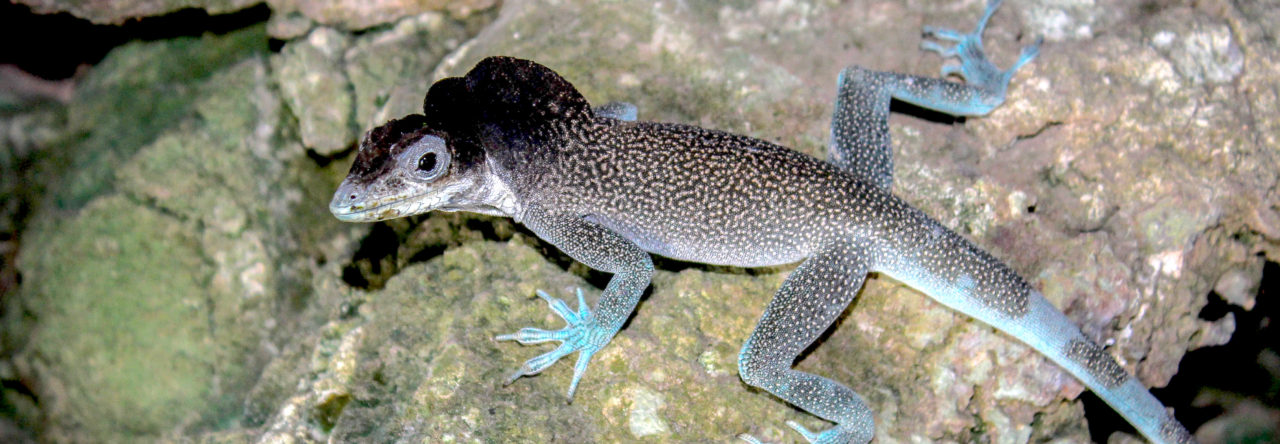Interactions between native Anolis carolinensis (green anoles) and invasive Anolis sagrei (brown anoles) in the United States are discussed often here on Anole Annals. Most recently, this blog featured a local news broadcast from Louisiana and newspaper article from Florida, both of which describe a pattern that is repeated across the southern United States: When brown anoles invade a habitat, green anoles begin perching higher off the ground and thus become more difficult for anole enthusiasts to find.
Why do green anoles and brown anoles tend to occupy different perch heights in areas where they co-occur? By far the most popular explanation is that these species partition space as a means of partitioning resources, namely arthropod food. In simpler terms, they are competitors. But competition itself is not always simple. To better understand and study competition, biologists often classify competition as one of two types. Species can compete directly via aggressive encounters (termed “interference competition”) or indirectly through their shared use of a limited resource (termed “exploitative competition”). We know that green and brown anoles eat similar prey, suggesting that their competition is at least partly exploitative. Do they also engage in direct interference?
In a recently published paper in Oecologia, Katherine Culbertson (Harvard ESPP ‘18, former undergrad researcher in the Losos lab) and I tested the hypothesis that interference competition between native green anoles and invasive brown anoles occurs in the field. More specifically, we wondered if an asymmetry in interference competition might contribute to the vertical displacement of green anoles by brown anoles. To test for competitive asymmetries between the species, we used a classic method in behavioral ecology: tethered intruder trials. We presented adult male intruders to previously undisturbed focal individuals of the opposite species and videotaped the interactions. Intruders were tied around the waist with string at the end of a fishing pole with enough slack to move freely. We analyzed several aspects of the behavior of the focal lizards to evaluate asymmetries in interspecific aggression between the species: how often they attacked, how often they displayed (throat fan extensions, headbobs, and pushups), how often they retreated, and in what direction they retreated. (Disclaimer: Whenever an attack occurred, we ended the trial immediately so no lizards were harmed.)
As anticipated, we found that interference competition is asymmetric in favor of brown anoles, which are more likely to display and less likely to retreat from interactions than green anoles. In line with their arboreal tendencies, male green anoles also trend toward retreating upward more often than expected by chance. Somewhat surprisingly, these asymmetries are prevalent despite the almost complete absence of physical attacks (there were only two attacks in nearly one hundred trials, both by brown anoles). All told, our results suggest that signaling between the species and avoidance behavior by green anoles resolve most potential conflicts before they escalate to combat.

Many Floridians I’ve met in the course of my fieldwork have described brown anoles as bullies. Although anecdotal observations of animal behavior do not always reliably represent biological truths, in this case, the collective of observations made the residents I’ve spoken with are concordant with our data. Kudos to the many local naturalists who’ve shared their stories!
In closing, I’ll attempt to refine the metaphor of brown anoles as bullies, in acknowledgement that metaphors are often imperfect and with apologies to those who bristle at any attempt to anthropomorphize non-human animals. First, what makes a bully effective? On the playground, a bully might gain a reputation as such by initiating and winning a fight. Afterward, the mere threat of physical combat is often enough for the bully to exert his or her will on others. At our study sites, where green anoles and brown anoles have co-existed for several generations, brown anoles tend to dominate interactions with green anoles without attacking them. Perhaps physical combat is more common during the incipient stages of brown anole invasion, a hypothesis which could be tested by applying our methods across sites that vary in their invasion history.
Second, what’s the best way to deal with a bully? Many children learn to ignore bullies, a strategy rendered possible by the existence of alternative space to play or activities to engage in. Green anoles appear to find refuge in the canopy, where brown anoles seldom venture. Anecdotally, areas where no such canopy exists (i.e. areas with few plants or with only short, shrubby vegetation) are the areas where green anoles are most likely to disappear entirely following brown anole invasion. This hypothesis deserves a formal test.
Special thanks to the Aquatic Preserve Program run by the Florida Department of Environmental Protection for making this work possible. Check out the paper to learn more about our methods, results, and the implications of our findings.














